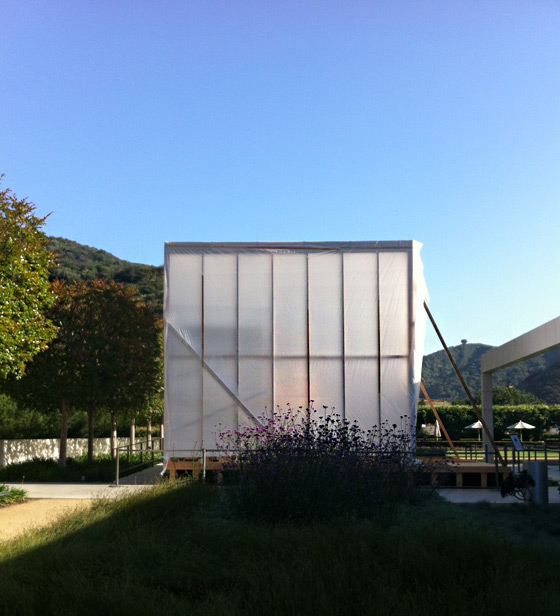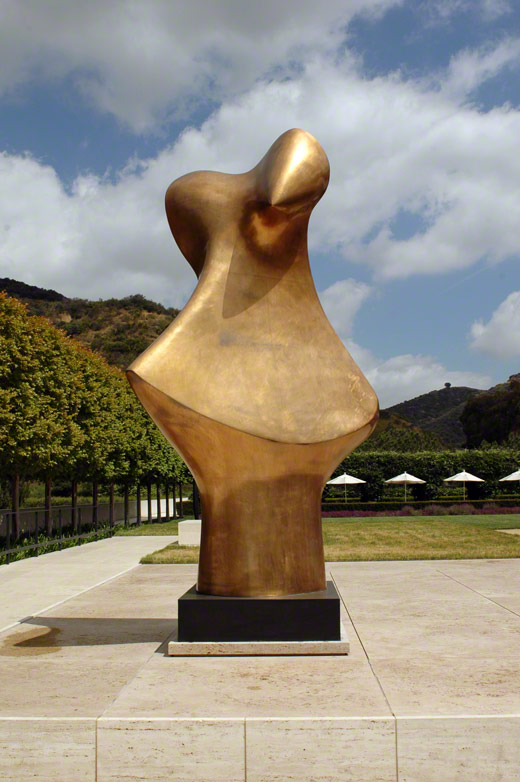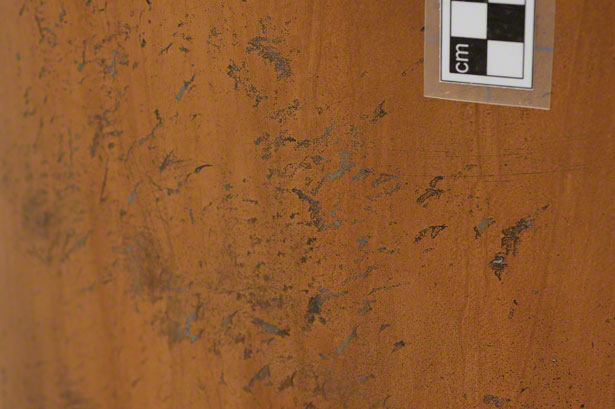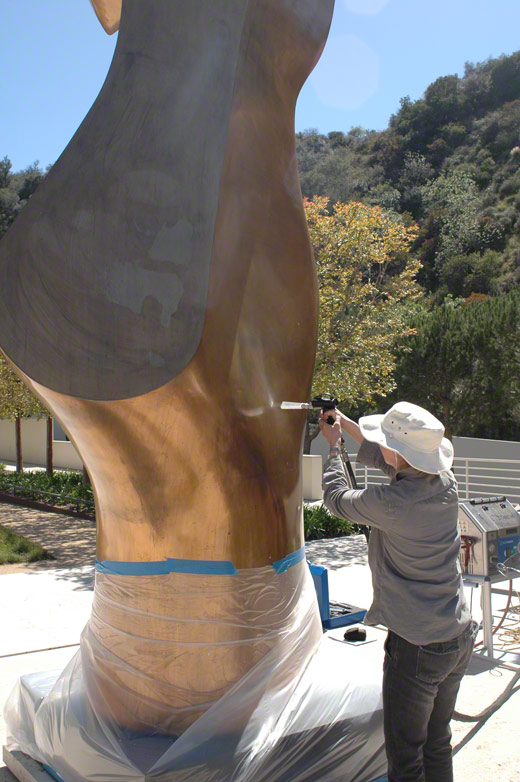
Under wraps: Henry Moore’s Bronze Form being conserved in situ at the Getty Center.
What’s inside this tent? Henry Moore’s monumental sculpture Bronze Form 5/6—normally the first artwork visitors see when arriving at the Getty Center—is undergoing a conservation treatment behind a rather mysterious-looking safety screen. My colleagues and I will be working on the sculpture outdoors through early June.

Bronze Form, Henry Moore, 1986. Bronze 14 ft. 6 in. high. The J. Paul Getty Museum, Gift of Fran and Ray Stark, 2005.117.1. © The Henry Moore Foundation. All Rights Reserved. / ARS, New York / DACS, London
Bronze Form and Large Figure in a Shelter are sculptor Henry Moore’s final two series of sculptures. They were fabricated in the artist’s native England in 1985-86 by welding together cast-bronze elements. Sculptures from these series are currently installed around the world, in cities as diverse as Copenhagen, Seoul, Wellington, New Zealand, and Grand Rapids, Michigan.
Bronze Form 5/6 came to the Getty in 2005 as part of the 28-piece gift of modern outdoor sculpture from Ray Stark and his wife, Fran. Their collection has been on view since 2007 in several areas around the Getty Center, including the Fran and Ray Stark Sculpture Garden just outside the tram station at the bottom of the hill. Moore’s Draped Reclining Mother and Baby from 1983 and Seated Woman are also included in this collection.
The Getty Museum’s Decorative Arts and Sculpture Conservation Department began research into the technical history of the Bronze Form as soon as it arrived, because it was apparent that the piece was in need of a conservation treatment. The sculpture came to us coated with a clear acrylic-urethane that had been compromised due to years of outdoor exposure. The failure of this coating was causing the surface of the sculpture to slowly darken. There were also breaks in the coating, which have allowed black and greenish corrosion to form. The goal for the upcoming treatment is to remove this coating and reapply a new and more protective one.

Scratches on the surface of Henry Moore’s Bronze Form

Abrasions on the surface of Henry Moore’s Bronze Form
Because it would be difficult to move the sculpture for treatment (it is over 14 feet high and sits on a massive pedestal designed just for it), our work is being done in situ. A large containment tent was fabricated around the piece and is allowing the conservation work to take place safely. Because the treatment involves the spray-application of a new coating, we have to ensure that no airborne particulates—whether from nearby construction work on the Getty Center entrance or from the 405 freeway—sticks to the surface while the coating is drying.
The first step in the treatment is to remove the old coating. We tested several removal methods, but decided to use a non-abrasive method known as Dry Ice Blasting. We are directing high-pressure frozen carbon dioxide (CO2) “snow” at the surface of the sculpture, creating localized thermal-shocks that separate the coating from the metal surface without affecting the metal or the fragile patina. The carbon dioxide method also thoroughly cleans the surface, preparing it beautifully to receive the new coating. We’ll then perform minor aesthetic tasks to help minimize irregularities on the surface caused by past treatments and damages, as well as to reduce the corrosion. As a final step, we’ll coat the surface with a new protective layer. Throughout the project, my colleagues and I will be collaborating with local conservator John Griswold, who has expertise in both sculpture and contemporary art.

Trial of the dry-ice-blasting and coating of Henry Moore’s Bronze Form
After the treatment, Bronze Form won’t look substantially different from the way it does today, but it will be better protected from the elements.
Our work will take place inside the containment tent, so visitors won’t be able to see the treatment as it progresses (or us conservators behind the barrier). I’m happy to take questions about the project here on The Iris and tell you more about what we’re doing behind the scenes!




I could only imagine how clean our cars would be after a nice dry ice wash. Actually, how would that affect the paint on a car?
And, what will the new protective coating be? Was the acrylic-urethan in essence not an effective coating or was it the outdoor elements that compromised it?
Good luck and I hope nothing gets in the drying coat!
Hi Jackie, Thank you for your interest! Dry ice blasting does have a wide range of applications, one of which is to safely remove mold from water-damaged books. However, we are using it at a higher strength (PSI) to actually blast off the coating from the surface of the metal. In order to preserve the paint on your car, I think you would be better off with a tried and true wash and wax from the carwash. . . .
As for the coating, the urethane did a good job for close to twenty years, but it has come to the end of its effectiveness. We are replacing it with a product called Incralac, which was developed for use on outdoor copper alloy (bronze or brass) objects. It bonds well to the surface of the metal, helping us ensure that the sculpture will be adequately protected. We will then add an additional layer of wax to the top of the Incralac. New wax will be applied annually as part of our maintenance program.
Fascinating article and project. Will visitors ever get to speak to the conservators like they did when Oudry’s “Rhinoceros” was on display in the Sketching Gallery while it was being conserved? I understand why they can’t watch as just keeping a clean environment, amongst the huge construction project of the 405, must be a challenge.
How long do you estimate this work will take?
Hi Deborah, Good idea, though a conversation “outside the box” hasn’t been planned for this treatment. The work is still on-going, likely for another week.
Thank you for writing!
Thanks for the great inside peek. I sometime get asked to look at bronze that has been left to the elements unprotected for years. By the time i get to it there is severe oxidation usually to the point of having a green patina to it. I have an exterior window frame project on an old bank I am looking at right now. Do you think that the dry ice would be able to remove the oxidation and bring me back to a bright bronze condition? Have you worked on anything that was left that long gone?
The point of the dry ice is to remove lacquer without damaging the surface of the bronze. You don’t have lacquer and its only a window anyway. Brass brush.
What of other statues at the Getty such as the marble ones? How do you protect them from the elements?
regards,
Madison Spencer